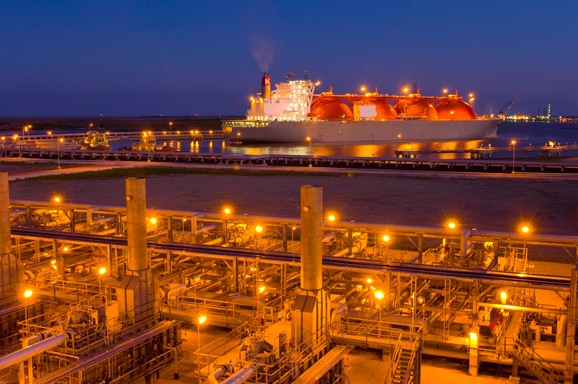Sabine Pass Liquefied Natural Gas (LNG) Terminal, Cameron Parish, Louisiana. Image: Bechtel
Sept. 3 (Bloomberg) — U.S. approval each year of 1.5 billion to 2 billion cubic feet a day of liquefied natural gas export capacity would be “palatable” for consumers, according to analysts at Sanford C. Bernstein & Co.
“We believe this level represents an amount of shale gas production growth that can be achieved with a reasonable, but not too high, price signal,” analysts including Bob Brackett said in a report published today. “If prices rise too fast or too severely, we believe U.S. energy policy makers will quickly hit the brakes and stall further capacity expansions.”
Cheniere Energy Inc., Sempra Energy and Dominion Resources Inc. are among companies seeking to build gas liquefaction plants so they can export the fuel to places such as Asia, where LNG costs are more than four times higher than U.S. gas prices. Their efforts are opposed by some U.S. lawmakers and businesses that have benefited from a 55 percent plunge in prices since 2008 amid increased production from shale rock.
The exports will raise gas prices as much as $1.02 per 1,000 standard cubic feet from 2010 levels, Bernstein said, citing estimates in a U.S. Energy Department-commissioned study.
Approving no more than 2 billion cubic feet a day each year would mean 5 billion to 8 billion cubic feet a day of liquefaction capacity would be under construction at one time, according to Bernstein. This would “allow the government to monitor price impacts as exports layer-in,” the analysts said.
U.S. LNG export capacity will total 6 billion to 7 billion cubic feet a day, or 50 million metric tons a year, by 2020, Bernstein said.
The U.S. Energy Department has given full approval to three projects including Sabine Pass LNG, Freeport LNG and Lake Charles Export LLC. A total of 20 projects “have been identified” in the U.S. and Canada with more than 200 million tons a year of LNG capacity, Bernstein said. That compares with current world-wide demand of 250 million tons a year.
– Robert Tuttle, Copyright 2013 Bloomberg.

 Join The Club
Join The Club











